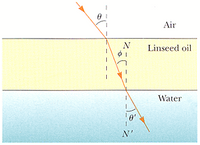Question
The light beam shown in Figure P22.21 makes an angle of ? = 19.5° with the normal line NN' in the linseed oil. Determine the angles ? and ?'. (The refractive index for linseed oil is 1.48.)
| ? | = ° |
| ?' | = ° |

Transcribed Image Text:Air
N
Linseed oil
Water
0'
N'
Expert Solution
This question has been solved!
Explore an expertly crafted, step-by-step solution for a thorough understanding of key concepts.
This is a popular solution
Trending nowThis is a popular solution!
Step by stepSolved in 4 steps

Knowledge Booster
Similar questions
- A light ray enters a rectangular block of plastic at an angle 0, = 47.8° and emerges at an angle 0, = 73.2°, as shown in the figure below. (a) Determine the index of refraction of the plastic. (b) If the light ray enters the plastic at a point L = 50.0 cm from the bottom edge, how long does it take the light ray to travel through the plastic? nsarrow_forwardWe know that the index of refraction of materials can help identify those materials. A light beam is shined onto a surface a reflected ray and is found to be completely polarized when the angle of incidence is 53.5°.(a) What is the index of refraction of the reflecting material? (b) What is the angle of refraction if some light passes through the surface of the material?°arrow_forwardThe incident light ray enters water from air with an angle of incidence 0₁= 46.8°. nair-1.00. nwater-1.33. Find the angle of reflection in degrees. Normal format with 3 SF.arrow_forward
- A ray of light travelling through air encounters a 1.7-cm-thick sheet of glass at a 45 ∘ angle of incidence. Assume n = 1.5. How far does the light ray travel inside the glass before emerging on the far side?Express your answer in centimeters.arrow_forwardA beam of light enters from air into a slab of glass (nglass=1.5) along a surface tilted at a 45 degree angle from the horizontal. What is the angle?arrow_forwardOptical fibers are a central part of technology for rapid information transmission with a high level of efficiency. A new type of optical fiber is crafted with an index of refraction n = less than that of water in the vicinity of room temperature, where NH2O fact that n < nH20 potentially problematic if the fiber should be submerged? 1.25 = 1.33. Why is the O A. Total internal reflection would be frustrated, allowing loss of signal. O B. Internal reflection would actually be enhanced, so there is no problem. C. Electric eels might have free internet access.arrow_forward
- The figure shows a refracted light beam in linseed oil making an angle of ? = 15.8° with the normal line NN'. The index of refraction of linseed oil is 1.48. a) Determine the angle ?. b) Determine the angle ?'.arrow_forwardRed light is incident in air on a 30° -60° - 90 ° prism as shown. The incident beam is directed at an angle of ₁ = 40.20 with respect to the horizontal and enters the prism at a height h = 20 cm above the base. The beam leaves the prism to the air at a distance d = 54.2 along the base as shown. 45.66 1.36 30⁰ 1) What is 2, the angle the beam in the prism makes with the horizontal axis? 71.9 d degrees Submit 2) What is n, the index of refraction of the prism for red light? dviolet d Submit Submit 02 3) What is 3, the angle the transmitted beam makes with the horizontal axis? h degrees Submit 03 degrees Submit (+) 4) What is 41,max, the maximum value of 1 for which the incident beam experiences total internal reflection at the horizontal face of the prism? degrees Submit + + 5) The red beam is now replaced by a violet beam that is incident at the same angle 1 and same height h. The prism has an index of refraction nviolet = 1.46 for violet light. Compare dviolet, the exit distance for…arrow_forwardConsider a light ray that enters and exits a prism as shown below. Suppose the material of the prism is unknown but the surrounding material has index of refraction n, = 1.3. Find the index of refraction for the material of the prism. n2 n1 22° 38° 9. n, = А. 1.479 D. 1.586 В. 1.635 Е. 1.333 С. 1.389 F. 1.527arrow_forward
arrow_back_ios
arrow_forward_ios